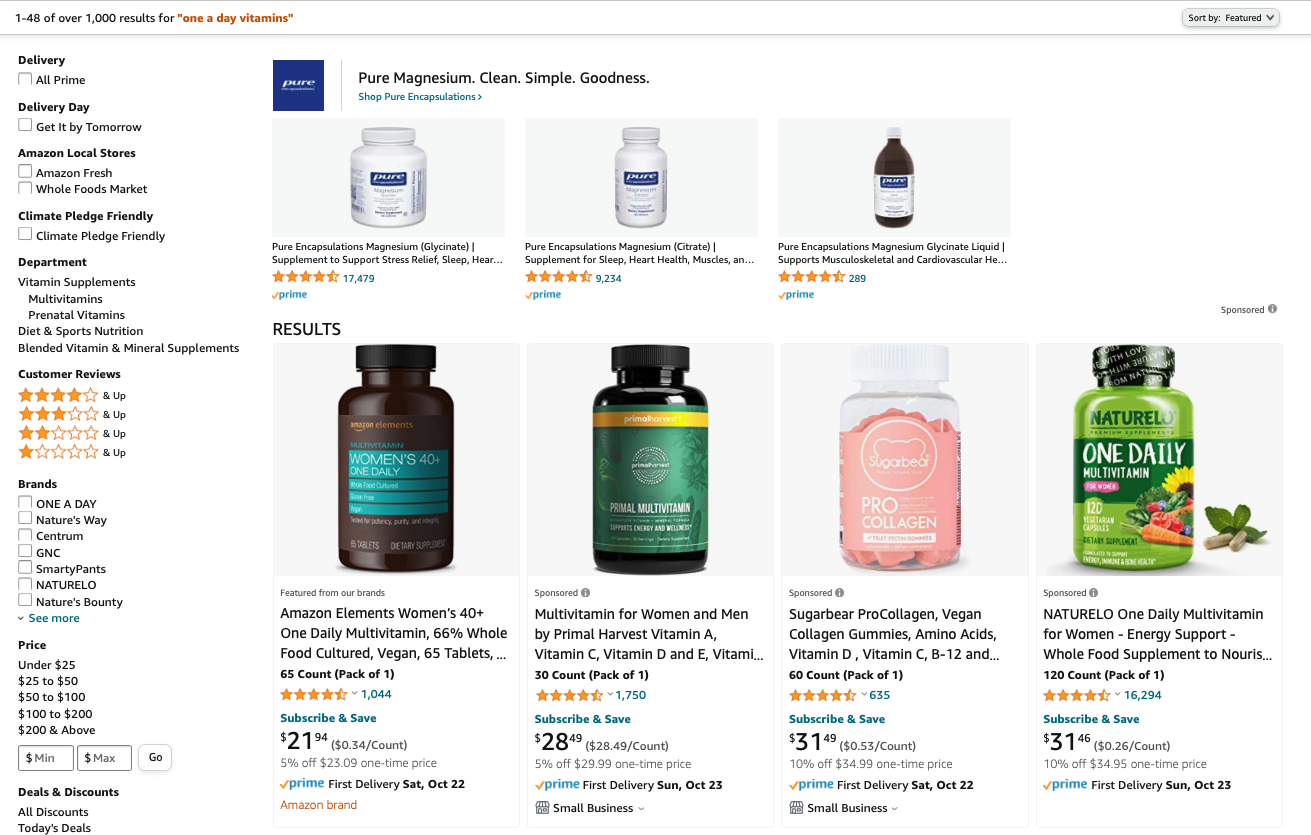A retail media network is an advertising network that a retail brand sets up within its own digital properties to give other brands the ability to advertise to their audience.
The most well-known retail media networks today are Amazon and Walmart, but many others include Best Buy, CVS, Home Depot, Instacart, and Wayfair.
According to Forrester, 74% of brands have dedicated budgets for retail media advertising, and it predicts retail media spending will grow to $50 billion globally in 2022.
How Does a Retail Media Network Work?
Retailers that want to allow other brands to advertise on their digital properties (website, mobile app, or other digital property) set up an advertising platform. Brands then use the platform to access the retailer's first-party data and run ads that will reach consumers when they are in-market.

Amazon's retailer media network shows "sponsored" ads.
Ads can be shown on various pages or sections of a digital property. For example, a brand can display an ad on the home page, a product page, a category page, or search results.
The Benefits of a Retail Media Network for Brands
Brands typically leverage third-party ad networks to run ads. However, with the planned end of third-party cookies and continued concerns over the accuracy and safety of ad networks, brands are looking for a better alternative.
Unlike a third-party ad network, a retail media network gives brands direct access to first-party data. This enables them to better understand their target customers and place ads where they know these customers are actively shopping (in-market).
In instances where the retailer has a loyalty program, brands get access to even more first-party data and are able to send highly personalized coupons, offers, and promotions to targeted segments, increasing sales.
Retail media networks are brand safe because ads are displayed in a known and controlled environment (they don't have to worry their ads will appear next to inappropriate content). Many brands also see a substantial benefit in having a close relationship with larger retailers.
These networks are also privacy compliant: consumers have accepted the retailer's privacy and security policies giving brands the confidence that consumers know and expect they will see advertising from other brands.
Another significant benefit of advertising on a retail media network, as opposed to a third-party ad network, is that brands can tie their ad spend to sales much more easily because the sale is happening closer to the ad.
There is one drawback to advertising on a retail media network. Brands only have access to the first-party data within the network (a walled garden); they cannot take data outside the network to analyze against other advertising efforts. This means the ability to do cross-platform decision-making is challenging. Brands must recognize that the decisions they make within the retail media network can impact or are impacted by advertising efforts on other channels.
The Benefits of Retail Media Networks for Retailers
Retailers who set up retail media networks are building a new revenue stream that can be very profitable. However, to convince brands to advertise with them, these retailers must prove they can bring in the traffic needed for brands to reach the right customers.
According to Forrester, in 2021, a quarter of retailers generated over $100 million in revenue from their retail media networks.
It's not only retailers that can benefit from setting up a media network. Companies in other customer-facing industries with a strong digital presence can also set up media networks. For example, travel and airlines can serve relevant ads to their customers and create a new revenue stream.
Providing bottom-of-funnel ads is only that start for retailers who want to take advantage of their retail media networks. Some retailers are expanding ad offerings to include video and digital display, in-store advertising, catalog advertising, and serving ads outside their owned sites through DSPs.
Not all brands have the resources to create and manage their own retail media networks. To help them, companies like Criteo, Promote IQ, and Quotient Inc. help retailers set up and manage their media networks.
Examples of Retail Media Networks
Large retailers with retail media networks include:
- Amazon Advertising
- CVS Media Exchange
- Albertsons Media Collective
- Kroger Precision Marketing
- Ahold Delhaize's AD Retail Media
- Target Roundel
- Walmart Connect
- Sam's Club MAP
- Dollar General's DG Media Network
- Walgreen's Advertising Group
- DoorDash Advertising
- eBay Ads
- Instacart Platform
Niche retailers with strong retail media networks include:
- Retail Media+ by Home Depot
- Wayfair Advertising
- Best Buy Ads
- Chewy (coming soon)
Put it all in context in our Shopper Marketing Technology Landscape, where we show where Retail Media Networks and Retail Media Platforms fit into the ecosystem (and who the major players are).
Click here to learn how to reach credit card consumers via a Payments Media Network.

